Hack 31. Convert PAL to NTSC
| < Day Day Up > |
|
You can shoot on PAL format and then convert to NTSC for richer colors. DV video comes in two flavors: PAL, which is used in Europe, Asia, Australia, and most of the world, and NTSC, which is used in North America. PAL has better resolution and richer colors. You can shoot on PAL then convert to NTSC and have a better-looking NTSC project. 3.7.1. Getting to Know PALPAL is actually a superior format, having more natural colors, a higher resolution, and a more film-like frame rate (25 frames per second much closer to film, which is 24 fps). NTSC runs at 30 frames per second (well, 29.97 when in color). PAL also has a bigger frame size (720 x 576 pixels, compared to NTSC's 720 x 480), so it captures a larger image. Most commercial DV cameras area also available as a PAL model rather than an NTSC model. Video shot on a PAL model has a much better look than NTSC. But video shot on PAL gear will not play on NTSC DVD and VHS players. It won't usually even display properly on TVs in America. However, you can shoot on PAL and then convert to NTSC if you need to, and it will still look better. 3.7.2. Affordably Converting PAL to NTSCCommercial post-production facilities often charge an arm and a leg for this service up to $300 for a one-hour tape. And the result often looks jerky or slightly distorted. However, there is an easy way to do it at home, in the form of an inexpensive utility called DVFilm Atlantis 2 (http://www.dvfilm.com; $195), available for both PC and Mac.
Atlantis is also useful if you're making an NTSC project and having people in other countries shooting for you on PAL. I did this on my new film, Hubert Selby, Jr.: It/ll be better tomorrow (http://www.cubbymovie.com). A lot of the interviews were shot in Europe by friends, which saved me the problem and expense of having to travel there. 3.7.3. Preparing for ConversionFirst, you have to have your footage in a data format on your hard drive. You want to export it as an uncompressed file. Atlantis can deal with either QuickTime or AVI files. You have this option from almost all video-editing programs. It's usually under File
You will also need to configure the format, codec, frame rate, and audio rate of your movie. Figure 3-14 shows the Export Movie dialog box for Adobe Premiere. Notice the Settings… button, as well as the current configuration for the export settings on the bottom part of the window. You'll want to set up the options in your editing program to make sure it's exporting your PAL footage in PAL format. The default is usually to export as NTSC. If you do change it, and you normally work in NTSC, then don't forget to change it back when you're done. Figure 3-15 shows the export settings for Adobe Premiere. Notice the Pixel Aspect Ratio is set for D1/DV NTSC and needs to be changed. It will take a while to render (probably about 10 minutes per minute of video, perhaps more, depending on the speed of your computer). When it is done, drag and drop your file onto Atlantis. Figure 3-13. Exporting a completed timeline from Adobe Premiere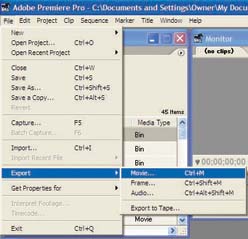 3.7.4. Using Atlantis for ConversionAtlantis is a tiny utility (350KB zipped for PC, 219KB for Mac) and a model of purity and simplicity. Unlike most programs that are packed with features you'll never use, Atlantis does only one thing, and does it better (and more simply) than any other program or process. It converts PAL footage to NTSC. (Actually, it does two things well: it also can convert NTSC to PAL.) When you double-click on the utility, you'll get a drag-and-drop welcome screen dialog box, as shown in Figure 3-16. To use Atlantis, drag your video onto the screen. You'll get a pop-up menu to configure your options. In addition to doing PAL to NTSC conversion, you also have options to experiment with letterboxing, adding film grain, and adjusting colors, as shown in Figure 3-17. I recommend experimenting with the letterboxing, film grain, and advanced options after you've done a simple conversion without them. To perform the actual conversion, click the Start button. Once Atlantis has started your conversion, you will get a pop-up status bar showing how long it takes to finish, as shown in Figure 3-18. Figure 3-14. The Export Movie window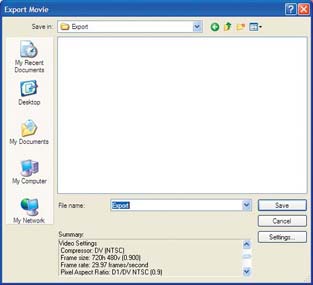 Figure 3-15. Exporting a DV AVI file in PAL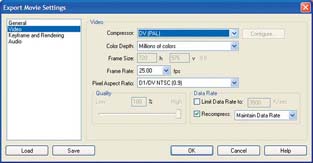 Figure 3-16. Atlantis's drag-and-drop welcome screen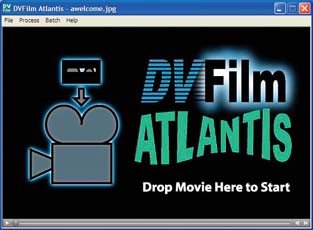 From there, the program does the rest. It does all the nifty background math it takes to make the conversion and spit out a new file, called new movie. When Atlantis is done, it sounds a tone and gives you a "Processing completed OK" box. You can then import your footage into an NTSC project and output to tape, or make a DVD from it. 3.7.5. Hacking the HackYou can also use Atlantis, if need be, to convert NTSC to PAL. This is great if you are making a film as an NTSC project but need to make a copy for the European DVD, or if you need to send your movie to a film festival abroad. Atlantis can tell which type of file you are dragging in. If you drag an NTSC file, it will convert it to PAL. If you drag in a PAL file, it will convert it to NTSC.
Figure 3-17. Atlantis conversion options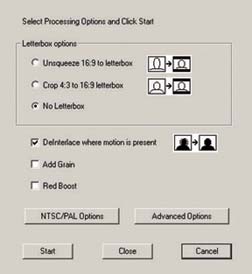 Figure 3-18. The conversion status bar You can also batch process a number of files, simply by using the batch command from the interface. I often do this before I go to sleep; Atlantis does all the work and has it ready for me in the morning. You don't need to worry about the audio; Atlantis takes care of that, too. All in all, I have to say "bravo" for Atlantis. There should be more things out there that solve a problem this elegantly. Michael W. Dean |
| < Day Day Up > |
EAN: 2147483647
Pages: 158

 Export Timeline/Movie, or something similar. You want to export as an uncompressed video. Figure 3-13 shows the initial steps to exporting a movie from Adobe Premiere.
Export Timeline/Movie, or something similar. You want to export as an uncompressed video. Figure 3-13 shows the initial steps to exporting a movie from Adobe Premiere.